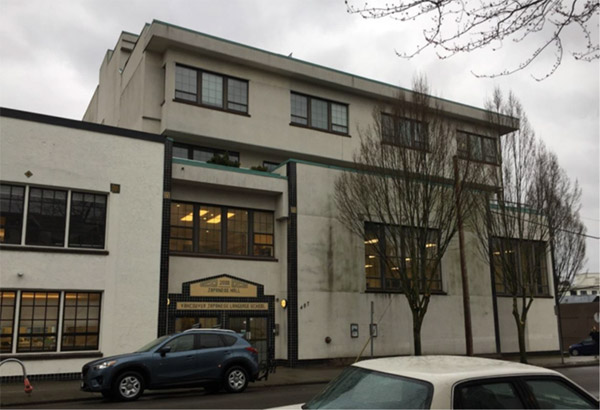Vancouver Japanese Language School National Historic Site

© Jennifer A. Cousineau, Parks Canada, 2018
The Vancouver Japanese Language School was designated as a national historic site in 2019.
Commemorative plaque: no plaque installedFootnote 1
The Vancouver Japanese Language School
The Vancouver Japanese Language School, located at 487 Alexander Street, was the first and largest Japanese language school in Canada and one of 50 such schools in use before 1941. It is a rare surviving example of an interwar language school in one of British Columbia's oldest immigrant neighbourhoods. During the Second World War, it was one of thousands of properties confiscated from Japanese Canadians by the federal government, and is one of very few known buildings to have been returned to its owners after the period of internment. It bears witness to the persistence of Japanese Canadians during wartime and postwar campaigns to recover their possessions and properties. Designed by Sharp and Thompson, one of BC's most successful architecture firms, this functional and elegant Art Deco school speaks to the growth, financial success, and cultural integration of Vancouver's Japanese community in the prewar period, and manifests the resilience and cultural pride of Japanese Canadians.
The Vancouver Japanese Language School was founded in 1906 and was originally located at 439 Alexander Street, down the street from the current location. In the 1920s and 1930s, the Japanese community flourished in Vancouver, particularly in the Powell Street neighbourhood. Among the community's most valued organizations were its language schools. Although the majority of Japanese-Canadian children attended public schools in this period, an immersive education in Japanese language and culture was given great importance within the community. In 1928, after successful fundraising efforts, the current building was constructed to replace the over-crowded original school building. The school's current Art Deco design reflects the community's economic vibrancy, the priority accorded to education, and the aspirations of Japanese Canadians in Vancouver to integration within Canadian society.
During the Second World War, Canada declared war on Japan, and beginning in February 1942, the federal government forcibly relocated Japanese Canadians living in BC to internment camps away from the West Coast. The next year, the government seized all property owned by people of Japanese descent in Canada, amounting to millions of dollars in farms, land, houses, boats, and commercial, industrial, and communal institutions. Most of it was sold, never to be recovered by its original owners. The Vancouver Japanese Language School was confiscated and used by the Department of National Defence, but was not sold. In 1953, after years of petitioning, the federal government returned the school to the Japanese Canadian community. Following considerable community fundraising, the building reopened to the public as a school and community centre, a function it has retained to this day.
Backgrounder last update: 2019-06-12
Description of historic place
Vancouver Japanese Language School National Historic Site of Canada is located in Japantown, in the Downtown East Side neighbourhood of Vancouver, British Columbia. Built in 1928, this two-storey, flat-roofed early modern building is designed in the Art Deco style with a white stucco exterior. A community hall was added in 2000. The school stands on the northeast corner of Alexander and Jackson Streets in a dense urban environment of mixed residential, commercial, and industrial architecture. The designation refers to the footprint of the building (the 2000 addition is excluded).
Heritage value
The Vancouver Japanese Language School was designated a National Historic Site of Canada in 2019. It is recognized because:
- It is a rare surviving example of an interwar language school in one of British Columbia’s oldest immigrant neighbourhoods. It was the first and largest Japanese language school in Canada and one of 50 such schools in use before 1941;
- Of thousands of properties confiscated from Japanese Canadians by the federal government during the Second World War, it is one of very few known buildings to have been returned to its owners after the period of internment. It bears witness to the persistence of Japanese Canadians during wartime and post-war campaigns to recover their possessions and properties;
- Designed by Sharp and Thompson, one of British Columbia’s most successful architecture firms, this functional and elegant Art Deco school speaks to the growth, financial success, and cultural integration of Vancouver’s Japanese community in the pre-war period.
The Vancouver Japanese Language School (VJLS) is a rare surviving example of an interwar language school in one of British Columbia’s oldest immigrant neighbourhoods, known as the Powell Street neighbourhood, “Little Tokyo,” Japantown, or Paueru-gai (in Japanese). Founded in 1906 at an adjacent site, the new building was constructed at its current location in 1928. It was the first and largest Japanese language school in Canada and one of 50 such schools in use before 1941. A highly valued community institution offering immersive education in Japanese language and culture, the VJLS is a site of memory for Japanese Canadians. It speaks to the history of their urban life, as well as to their interwar immigrant experiences. The school reflects the community's economic vibrancy, the priority accorded to education, and the aspirations of Japanese Canadians in Vancouver to integration within Canadian society. During the Second World War the school was confiscated and used by the Department of National Defence, but was not sold. In 1953, after years of petitioning, the federal government returned the school to the Japanese Canadian community. The building still functions as a school and retains the aesthetic of a 1920s school building.
Source: Historic Sites and Monuments Board of Canada, Minutes, June 2018.
The National Program of Historical Commemoration relies on the participation of Canadians in the identification of places, events and persons of national historic significance. Any member of the public can nominate a topic for consideration by the Historic Sites and Monuments Board of Canada.
- Date modified :